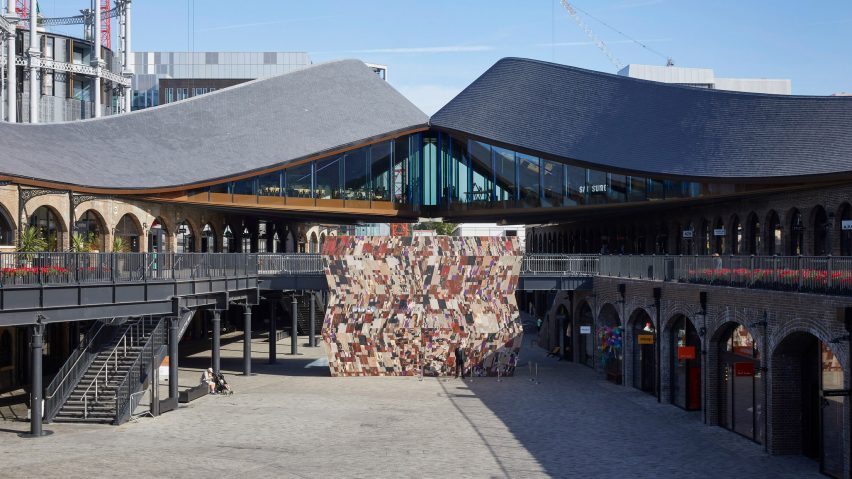Designer Martino Gamper has created a fake front for a "disco" at Coal Drops Yard in London's King's Cross that can house just a few revellers at a time.
The designer's Disco Carbonara is a large facade made from a patchwork of cladding that the designer created from waste offcuts, which hides a tiny disco.
It is supported on a regular scaffolding structure and stands as a "gateway" within the north London shopping complex that is a London Design Festival design district for the first time this year.
The edges of the facade are zigzagged. Together with the positioning of the patchwork cladding this creates the optical illusion that the installation has a concertina form.
"The idea is that you can look at it, but also look into it and experience it," Gamper told Dezeen.
A double door at the base of the structure leads into a small space playing disco music with colour-changing lights, that can hold a handful of people.
The cladding for the facade is made from leftover waste from the wood veneer industry, specifically an Italian company called Alpi that Gamper had worked with previously.
He intends to produce tables and other items from the wood surface once the installation is taken down.
"It's quite a tricky brief to make something large-scale, colourful and impressive, that's sustainable and can be produced cheaply and quickly," said Gamper.
The designer made the wood surface by glueing layers of veneer sheeting together in a deliberately imperfect block. By slicing through the block, the colour of each veneer layer comes through.
He chose the "leopard skin" colours of the veneers to give the feel of a 1970s disco and match the name of the structure.
"Being Italian and going back to the disco days, I thought it needed to be something cheesy, so Disco Carbonara" Gamper told Dezeen.
"It's something weird and funny but with a bit of history to it, as not many people know that spaghetti carbonara is for the charcoal makers, or for anyone who's working hard like miners or coal workers."
The design was inspired by the LA Olympics of 1984, which according to Gamper was pulled together in very little time on a shoestring budget using scaffolding structures and printed materials, as well as the concept of a Potemkin village.
The term comes from stories of a fake portable village built to impress Empress Catherine II by her lover Grigory Potemkin during her journey to Crimea in 1787.
It also inspired the architects behind this year's Antepavilion, the Potemkin Theatre, a three-storey canal-side theatre in east London.
The playlist for the miniature disco is curated by Gamper, along with his friend Daniel Pemberton, who composes music for films.
Other installations on show during London Design Festival include undulating bench seating made from scaffolding boards by Paul Cocksedge and a bamboo and a carbon fibre ring by architect Kengo Kuma installed in the V&A's garden courtyard.

